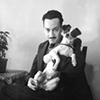Nicolás Muller
-
My father always wanted to be a photographer since he was given his first camera at age 13, a 6x9 plate ICA with a Novar Anastigmat 1: 6.8 lens and a tripod. That one was stolen soon but it was replaced by a Rollei 4x4 that, incidentally, he used until his first professional jobs, back in 1937.
Before exiling himself from his native Hungary, he had to graduate in Law and Political Science for family reasons. In those university years he met friends who had common interests and toured the small country to document the reality of that time. Hungary, then, lived under a semi-feudal regime, and those photos have become documents that reflect with a modern look, images full of dynamism and vitality, starring people who had little or nothing and who worked from sunrise to sunset in conditions very precarious.
Photographing the human being was his first, and perhaps only, source of inspiration. It was not invasive to approach people: for many years his equipment was a Rolleiflex that he had around his neck and a photometer, in case there was a need. He always considered that his work in B / W was more interesting than color, which he also had to do due to professional demands.
His career spanned from 1938 to 1980. At 25 years old, Paris was his first goal and his first joys as a freelance. He was there for a short time, but he took brilliant photos, in my opinion. Some will be known soon ... Then he made a stop in Portugal where he also reflected with sensitivity and respect to that population that in 1938 lived on the bare minimum.
He landed in Tangier in 1939 and that light, and that exoticism, dazzled him. Of the years he lived there until 1947, he always said that they had been the happiest ... his work reveals it well. Many of his images are well known, and he always regretted how battered they were under the scissors of the publishers and printers of the time.
Finally, he arrived in Spain, where he settled forever, from 1948 to 2000, where he died. Here he was able to work at ease and with pleasure. He had a different look to what was done at that time, his portraits devoid of sophistication were direct and real. I was amazed at his field work: with the fewest resources, whatever light he did, he found the shot, the frame and the moment of the shot. When you see your contacts, you immediately understand what a good eye knows about that decisive moment.
He was an instinctive photographer who was not too interested in technique or the laboratory, but was very aware of the importance of having a camera in hand to express thoughts and ideas with it, and always with an aesthetic gaze.


